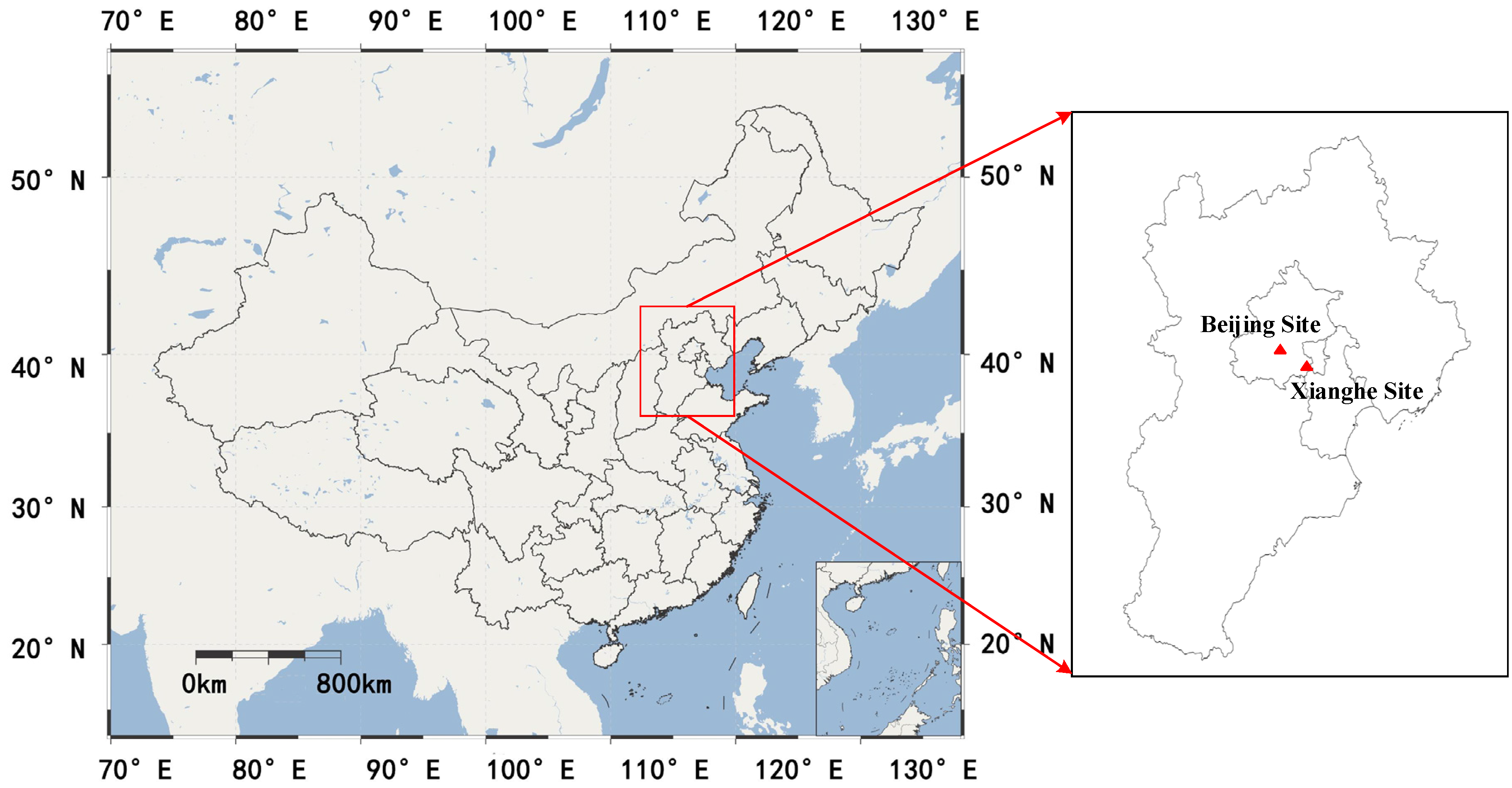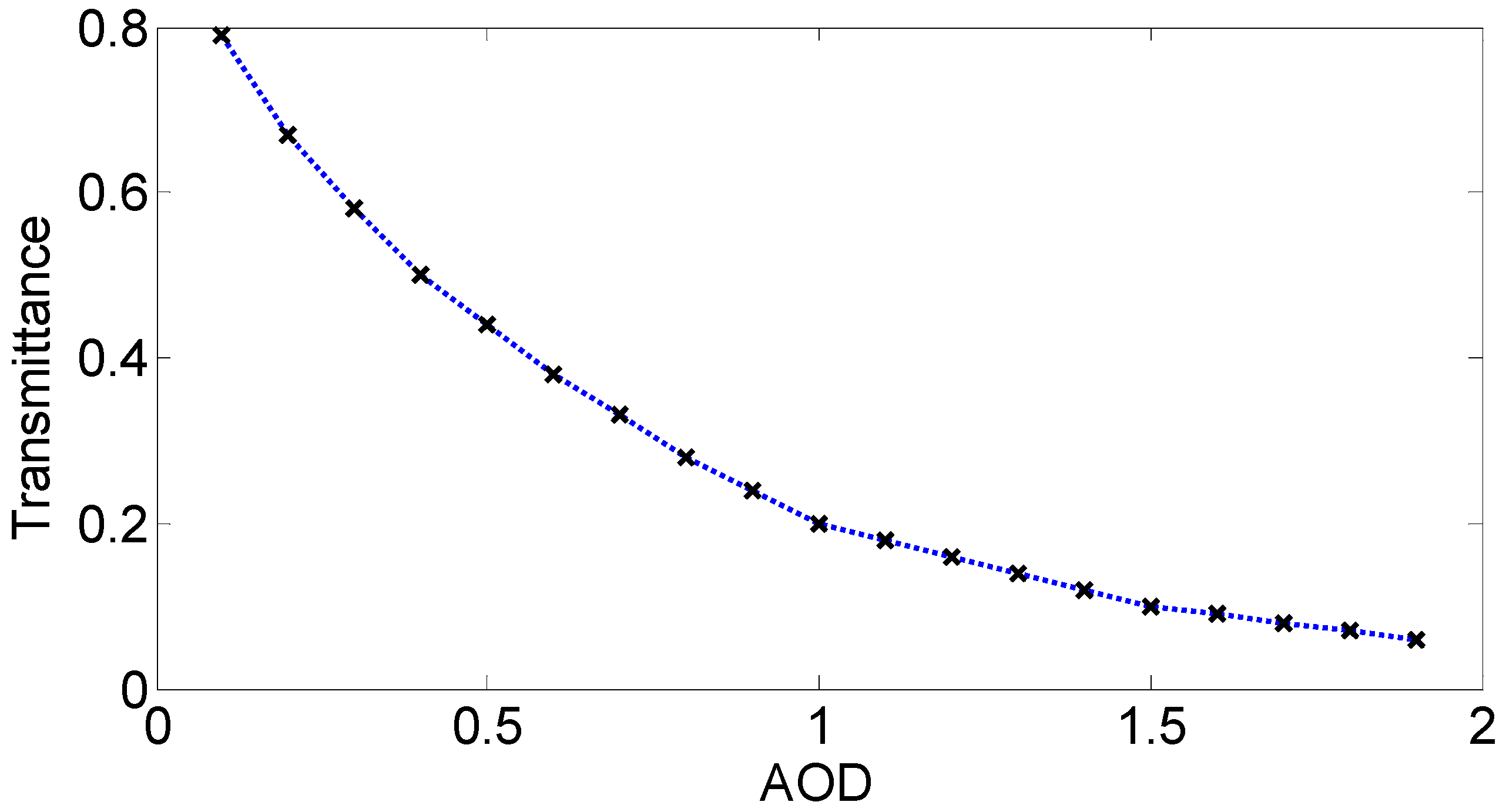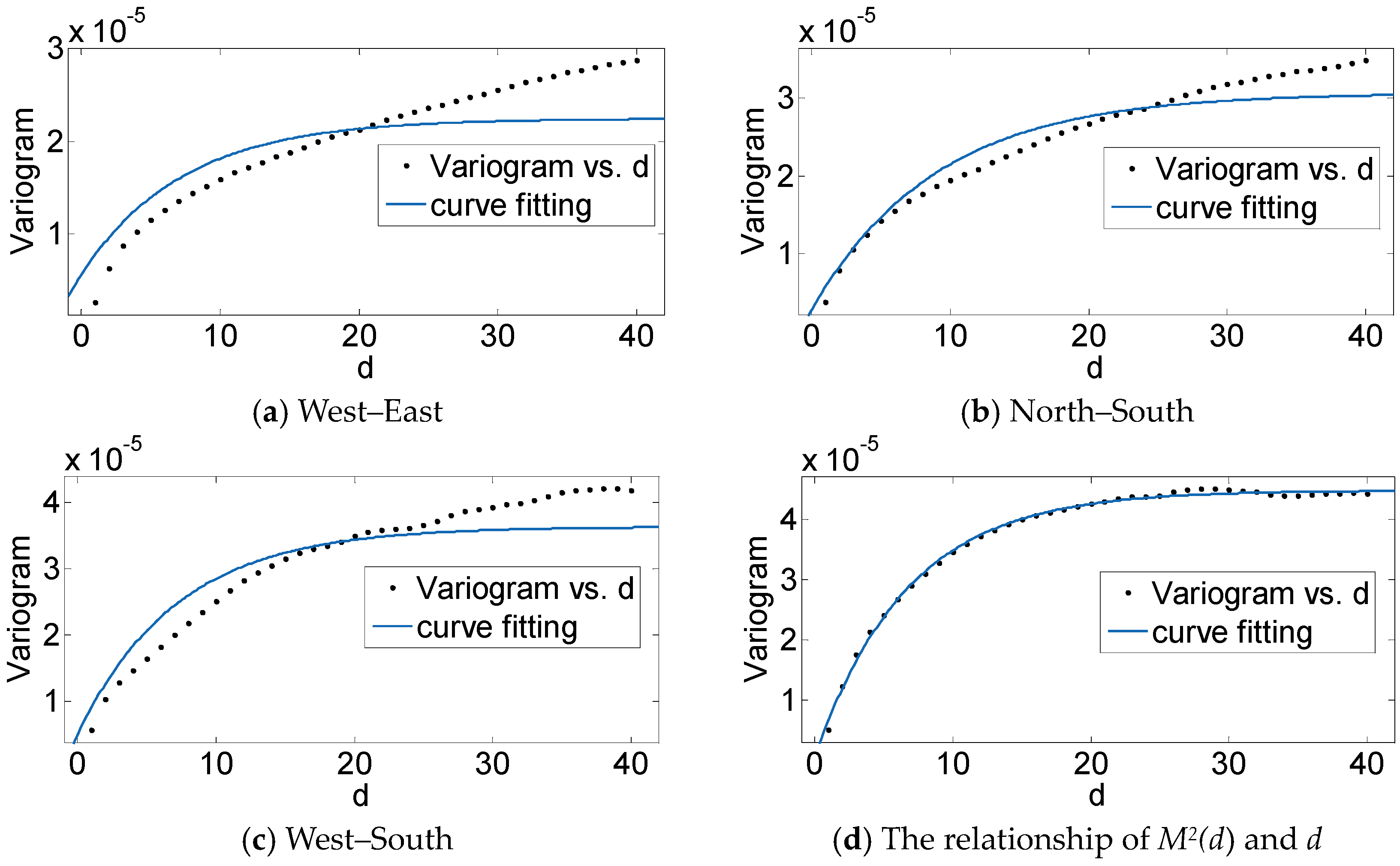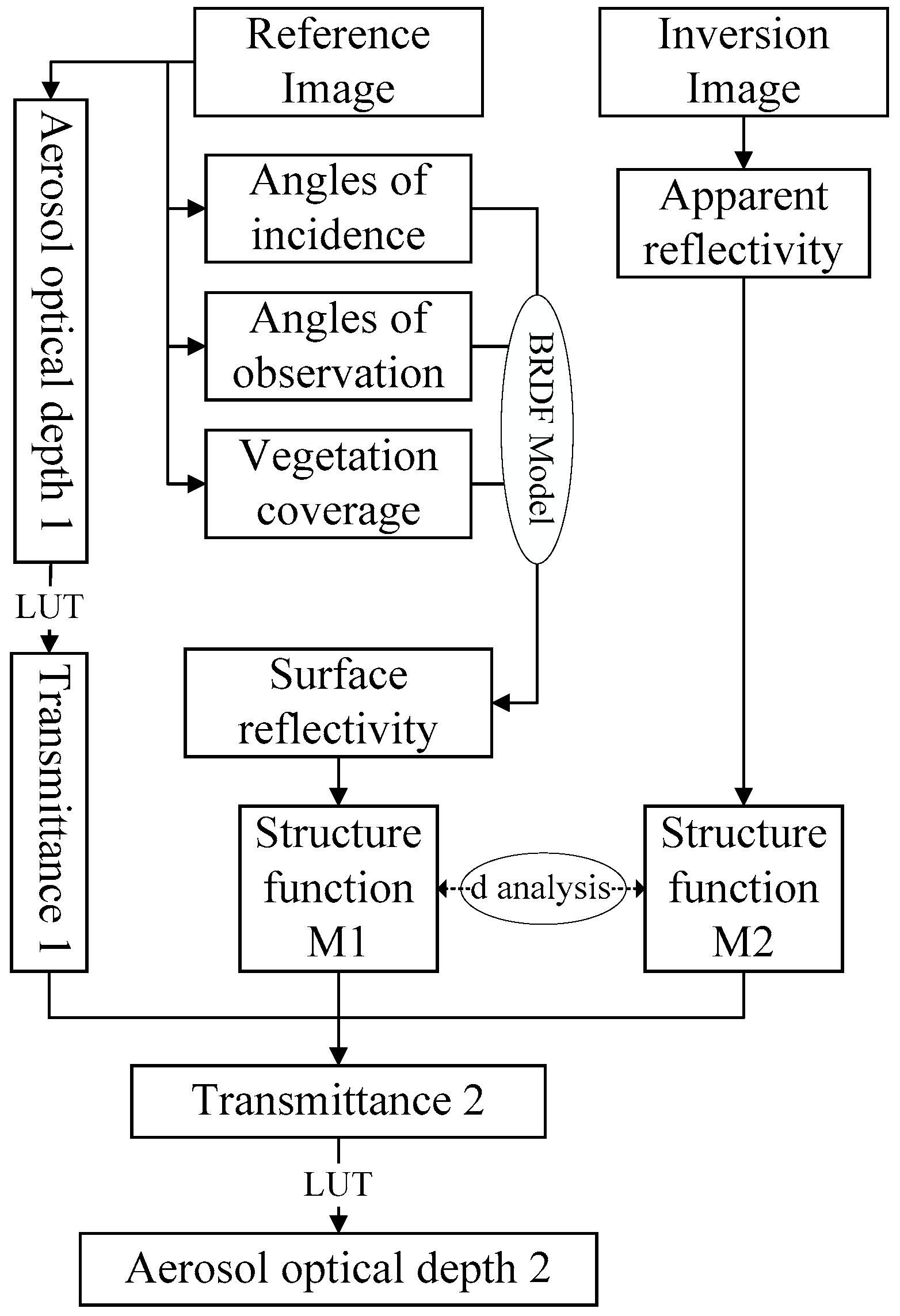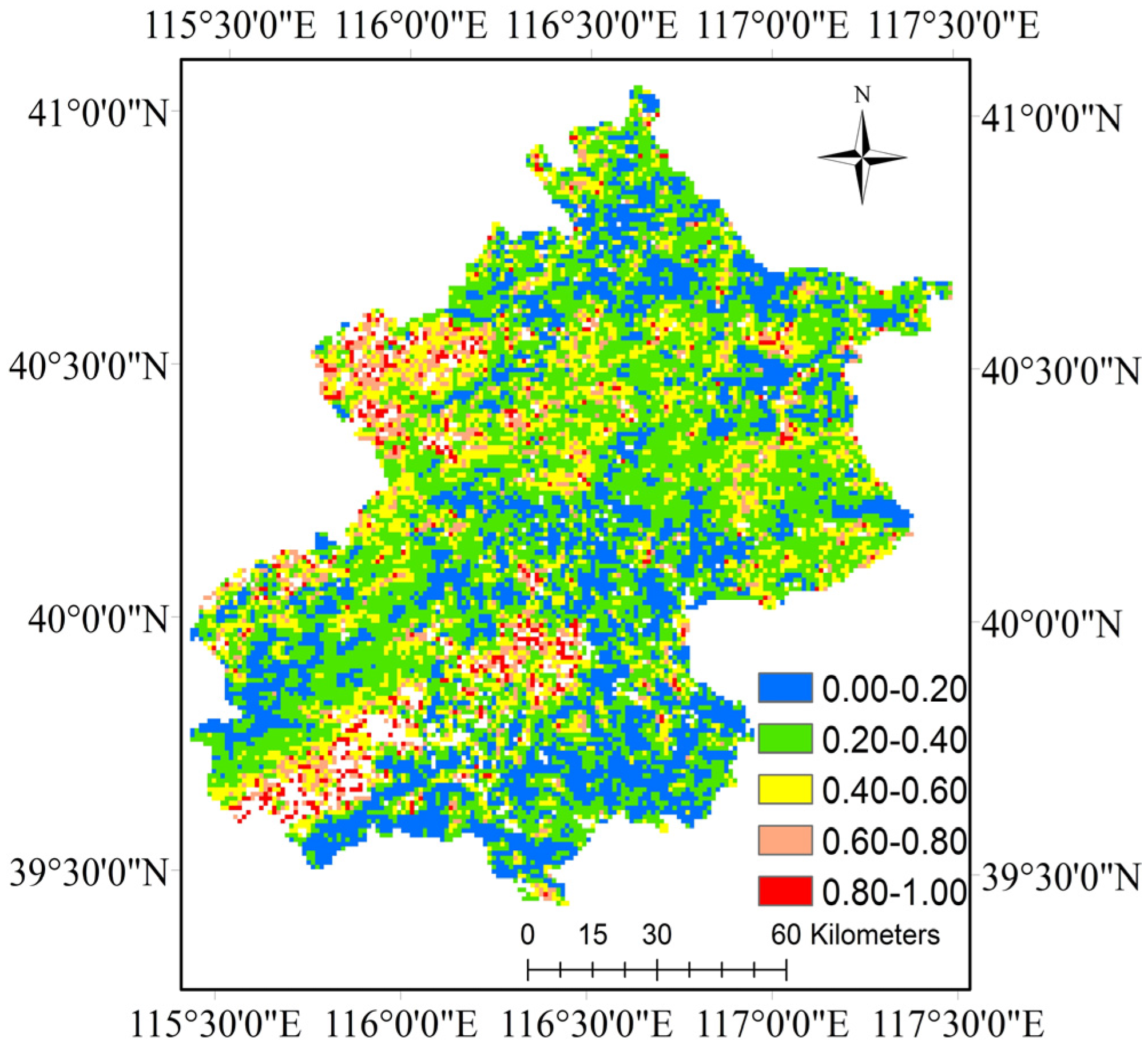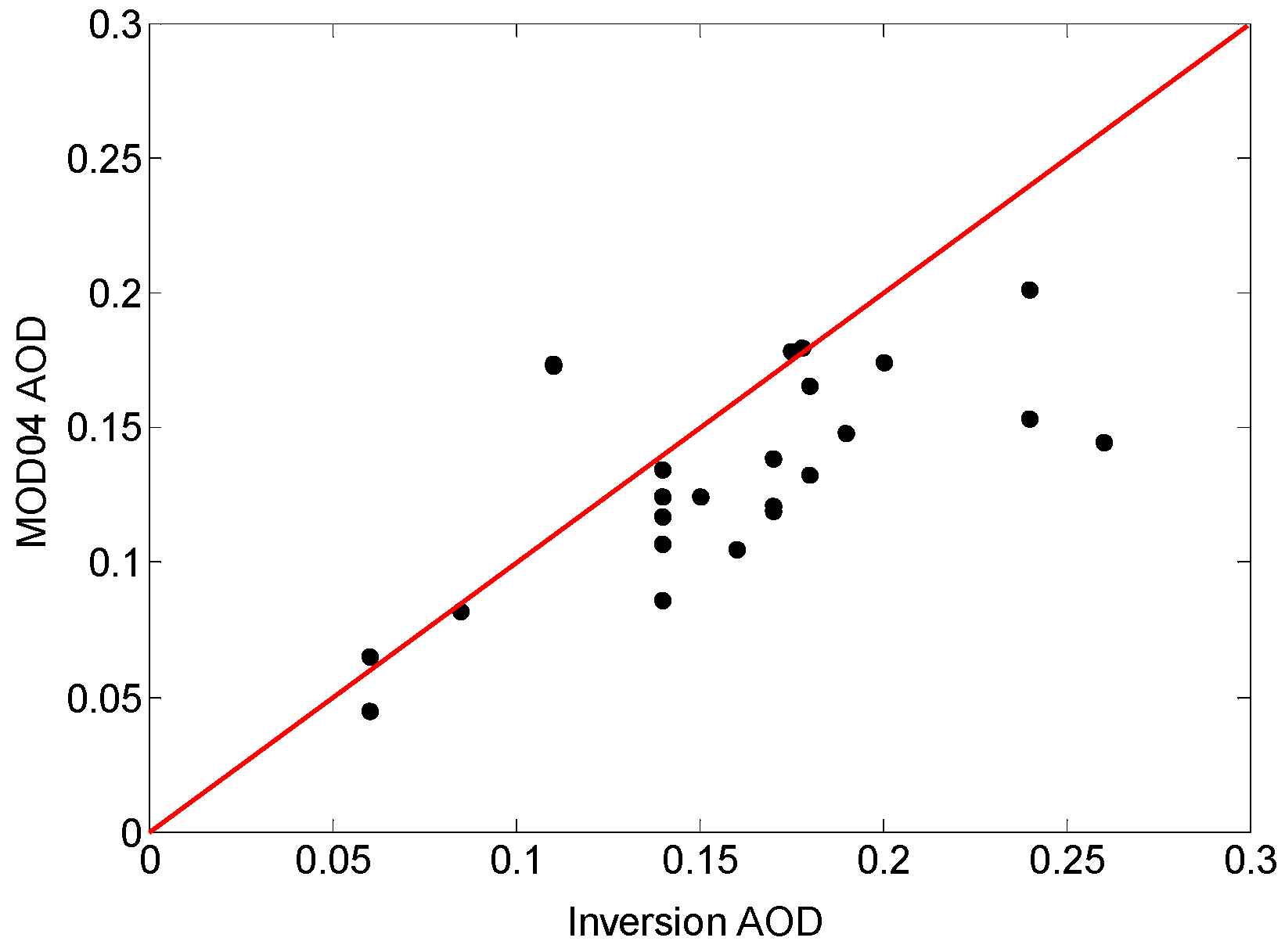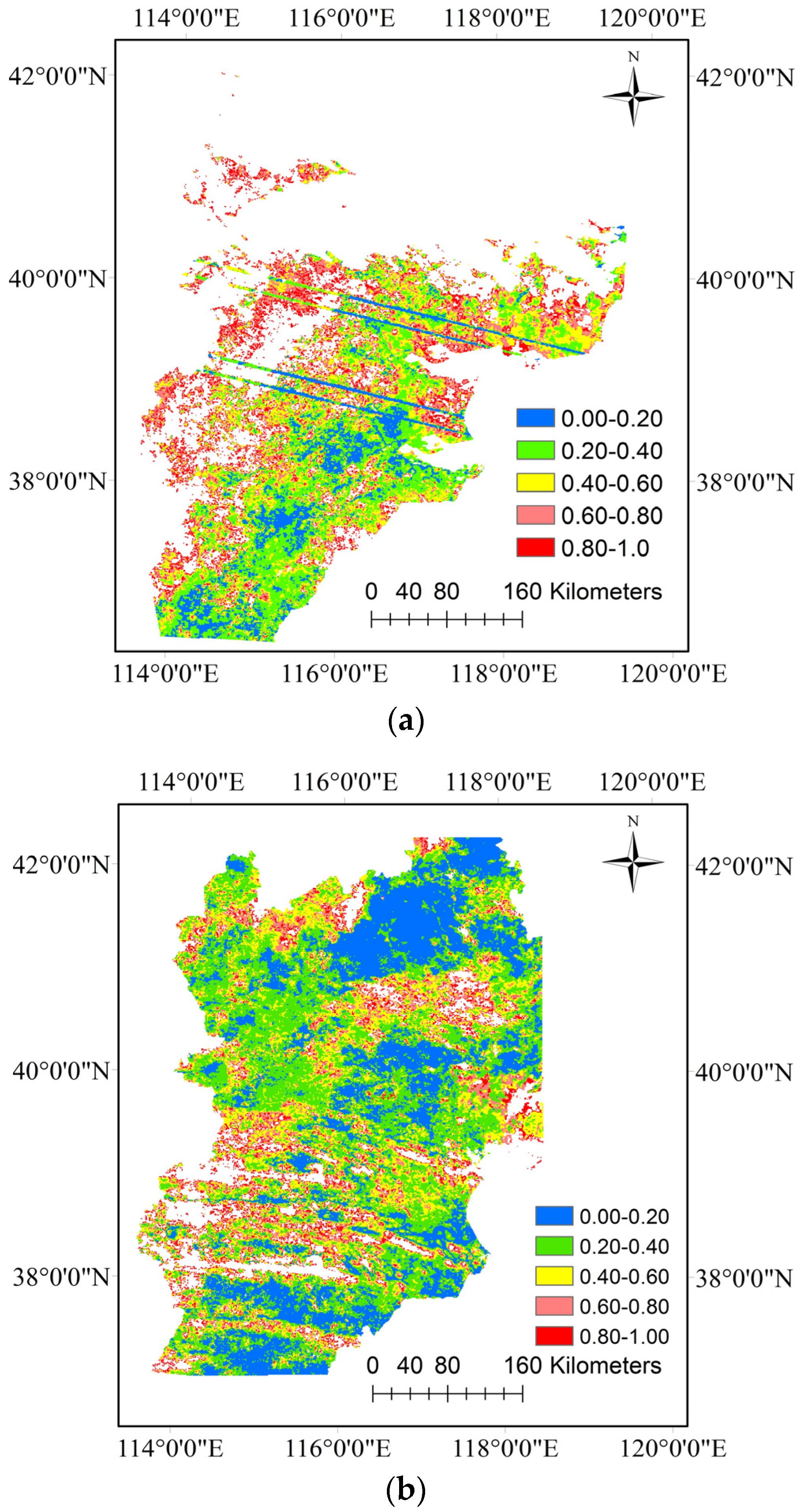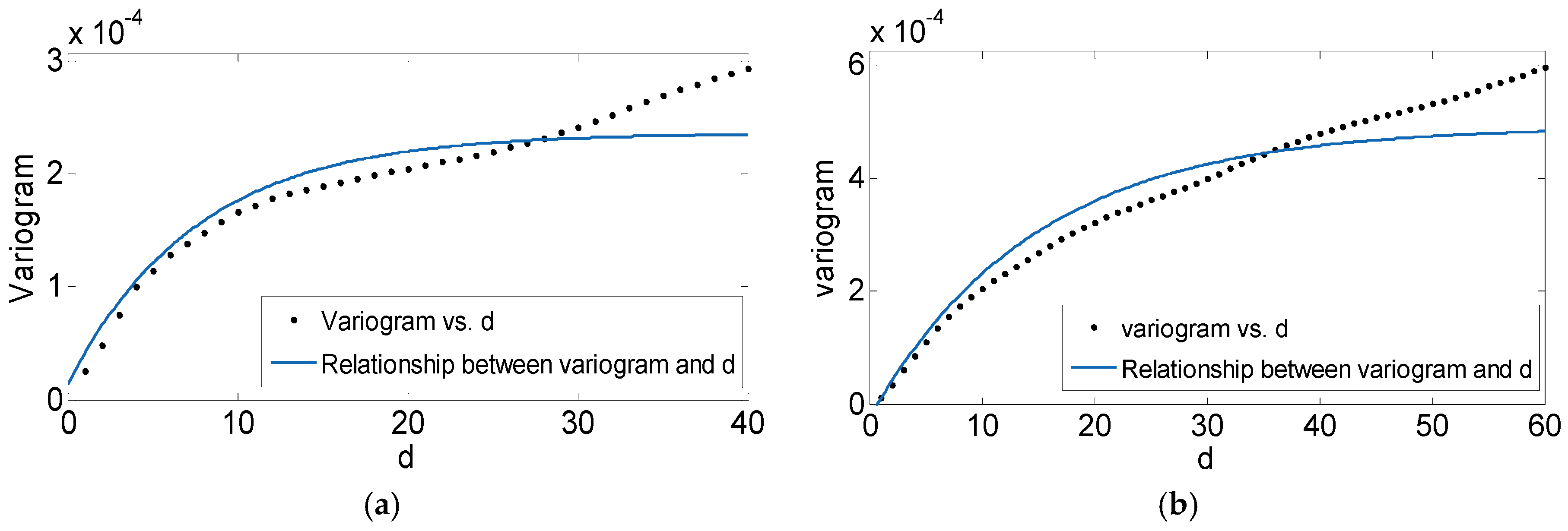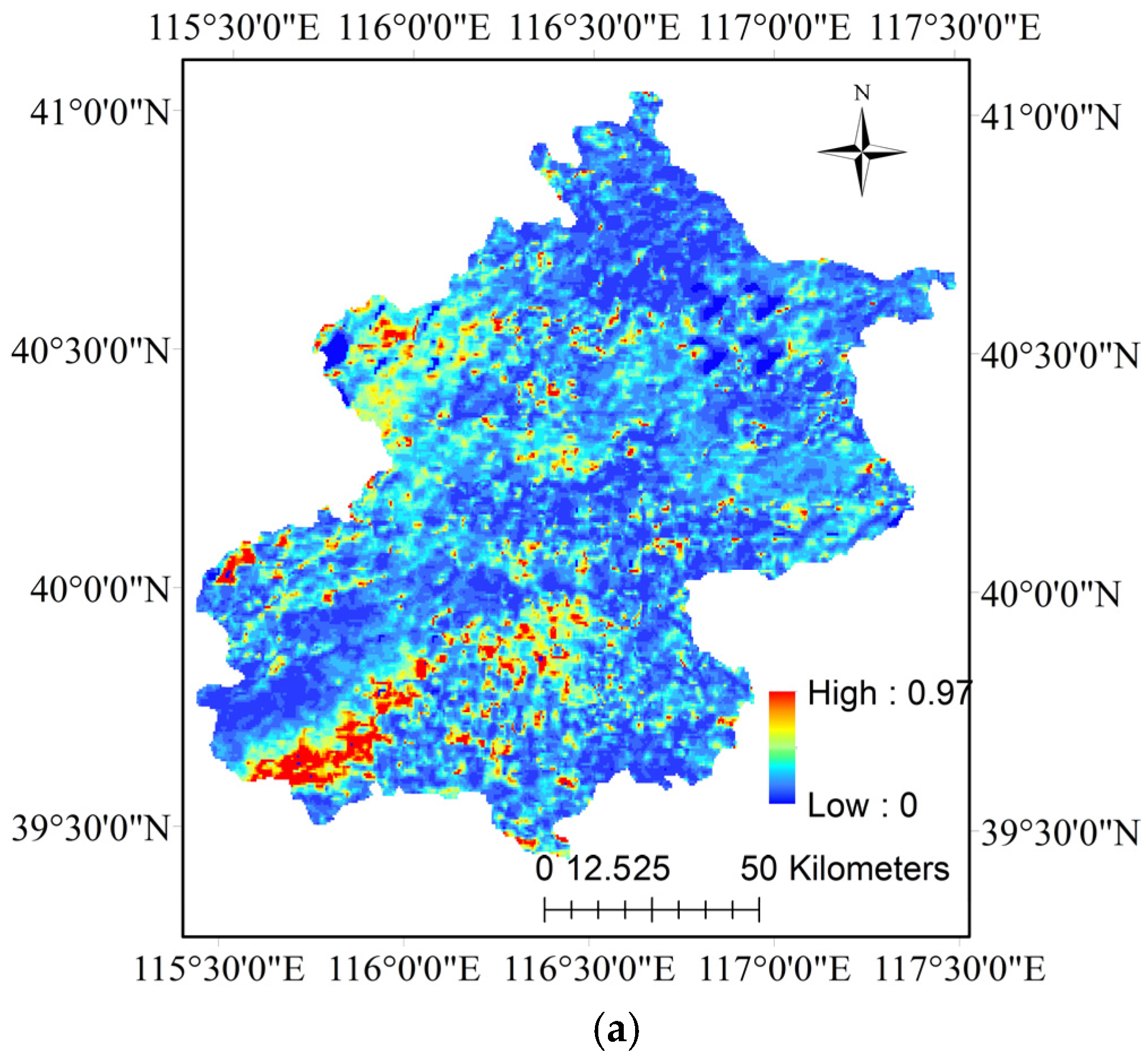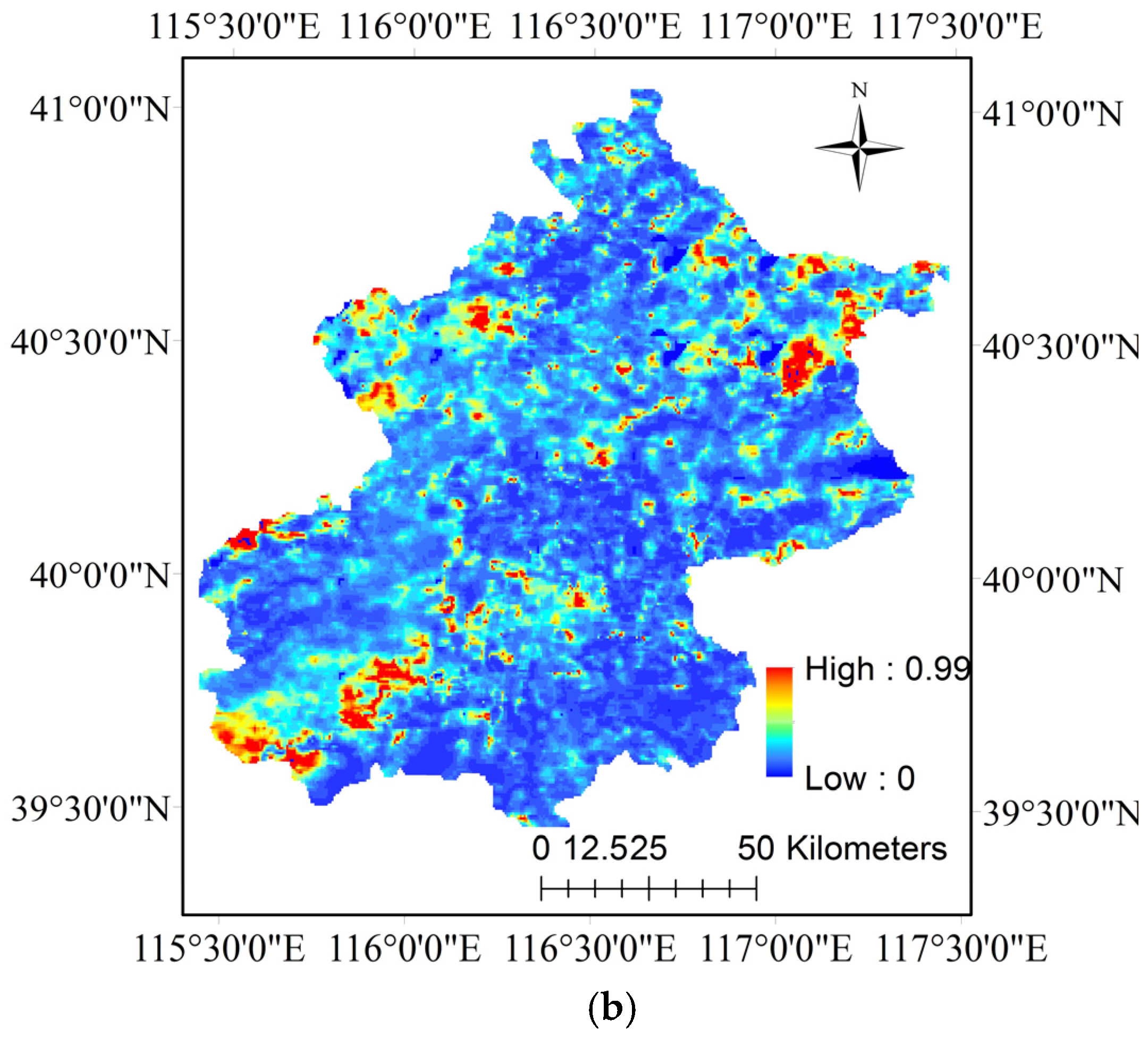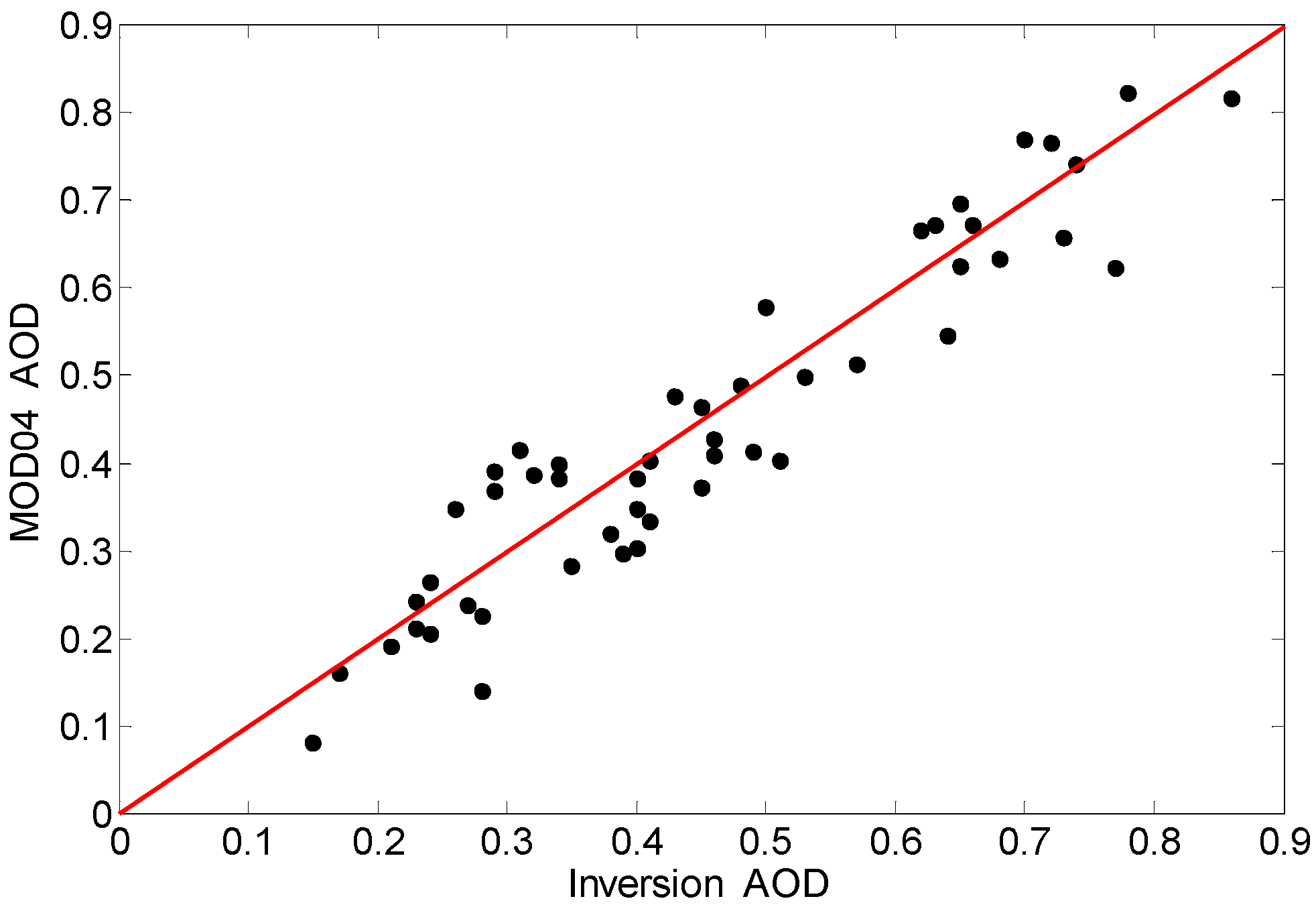2.1. Data
In order to monitor the Earth’s systems—including atmospheric aerosols—NASA’s Earth Observing System (EOS) program launched the Terra and Aqua satellites on 18 December 1999 and 4 May 2002, respectively [
18,
19]. Moderate Resolution Imaging Spectroradiometer (MODIS) is a key instrument mounted on the Terra and Aqua satellites, providing a global detection every one or two days, by using 36 bands in 0.4–14 μm, a 2330 km wide swath, and three different spatial resolutions of 250 m, 500 m and one kilometer [
20], while the resolution of the aerosol optical thickness product (MOD 04 product) is a 10 km × 10 km grid box produced by the MODIS aerosol algorithm [
21]. All the MODIS Products can be found and downloaded at the Level 1 and Atmosphere Archive and Distribution System (LAADS) website [
22].
The Aerosol Robotic Network is a globally distributed observation networks of ground-based sun photometers that provides high quality aerosol measurements [
23,
24]. AERONET provides a long-term, continuous and readily accessible public domain database of aerosol optical, micro-physical and radiative properties for aerosol research and characterization and validation of satellite retrievals. The measurements can be used to compute aerosol optical thickness at eight wavelengths (340, 380, 440, 500, 670, 870, 940 and 1020 nm) [
25,
26]. The uncertainty of aerosol optical thickness varies spectrally ±0.01 to ±0.02, thus it is widely used as one of the ground-truth observations to validate the MODIS retrieval results [
27,
28].
This paper utilizes one kilometer resolution MODIS L1B data and three kilometers resolution MOD 04 aerosol products. The acquisition dates of clear images are 8 February 2015, 10 February 2015 and 5 January 2016. Acquisition dates of inversion images and MOD 04 product are 10 February 2015, 14 February 2015, 7, 12 and 25 January 2016, as were the AERONET observations. The study region is shown in
Figure 1. Aerosol optical thickness was retrieved in both Beijing and Beijing–Tianjin–Hebei regions. The study areas were chosen based two considerations. First, in winter, the vegetation coverage of the Beijing–Tianjin–Hebei regions is low, so the surface renders high reflectance characteristics. Second, Beijing and Xianghe site observations could be obtained to verify the accuracy of inversion and MOD 04 AOD.
2.2. Method
Tanre et al. [
11] defined and used a structure function to derive the aerosol optical thickness over land surface from satellite data. By assuming the ground reflectance was invariant during a certain period, variations of satellite signal may be attributed to variations of the atmospheric optical properties. It is also assumed that the atmosphere was horizontally uniform and the surface was Lambertian. As mentioned by Tanré [
11], the apparent reflectance,
, observed by the satellite could be written as
where
and
is the solar zenith angle,
and
is the satellite zenith angle,
is the relative azimuth angle between solar and satellite,
is atmospheric reflectance,
T is the total transmittance on the sun-ground path,
is the ground surface reflectance,
is the atmospheric optical depth,
is the mean surface reflectance,
td is the diffuse transmission function on the ground-satellite path, and
s is the atmospheric albedo.
We assume the multiple reflective interactions between the surface and the atmosphere are small and thus can be ignored in clear weather. That means the term approach to zero. Furthermore, let us assume the environmental contribution of the surroundings is equivalent, i.e., the values are the same in a small local area.
Consequently, the apparent reflectance difference,
, of two adjacent pixels in spatial dimension,
and
, with distance
d can be derived from Equation (1):
where
i and
j are the row and column indices of the image, respectively. If the surface property does not change in the observation period, i.e.,
is constant, the difference of the apparent reflectance may be a function of the optical depth. Then, the relationship
and
can be expressed as
We can replace
by
, then, we get
and
where
and
represent two different dates.
is so close to
that it was assumed that the surface reflection characteristics of these two days did not change. In other words,
can be replaced by
. We assumed that the day
was a clear day, and the aerosol characteristics did not vary from
to
. Then, we can get
From Equation (8), we know when
d is large (rather than a few pixels), then
is no longer correlated to
;
and
reduce to the standard deviations,
and
. Let
and
stand for the apparent structure functions of some scene from satellite images at two various dates
and
. In addition we replaced
and
with
and
. Then, the structure function method can be expressed by
where
T denotes atmosphere total transmittance which is determined by solar zenith angle, sensor zenith angle and aerosol optical depth
. As shown in
Figure 2, the atmosphere transmittance has a negative relationship to the AOD. This connection can be simulated in Second Simulation of the Satellite Signal in the Solar Spectrum (6S) model. If the aerosol optical thickness
is given, then we can calculate
T1 via a look-up table (LUT) about Transmittance and AOD. The structure function value
and
can be calculated with Equation (3). When we get the ratio of
to
(which is also the ratio of
T2 to
T1), the transmittance
T2 can be obtained. Finally, we calculated AOD
via the same lookup table regarding Transmittance and AOD.
Holben et al. [
12] put forward a kind of algorithm to calculate the value of structure function:
where
m denotes the number of rows and
n the columns. The parameter
denotes surface or apparent reflectance. The
d value must be set artificially before the calculation. When the
d value is changed, the structure function values will also change accordingly, whereby the ratio of two structure function values, and also transmittance ratio, will change. As the structure function values are generally small, a tiny change of structure function value can make big change to the ratio. If the step of Transmittance and AOD in the lookup table is not small enough, the error of calculated AOD value may greatly increase. Therefore, the AOD inversion results will be significantly affected by the
d value [
11,
17].
One of the main theories used in geostatics is the variogram, which is used as a theoretical function. It is the actual realization of the random process
on the ground [
29,
30]. As the variogram is also known as a ‘structure function’, the algorithm of structure function (Equation (8)) is similar to that of the variogram (Equation (11)), so we applied the geostatistics method to determine the
d value.
In a particular direction, along the one-dimensional x-axis, for example, the semivariogram
can be described as
where
h is the separation between samples in both distance and direction;
and
are the values of
Z at places
x and
x + h; E denotes the expectation, and Var denotes the covariance; 1/2 is just for convenience without practical significance, so we generally call
the variogram.
Variables, such as air temperatures, rainfall, the heights of underground water level, and the concentrations of elements in soil, for example, are regarded as spatial random effects. However, for each of these variables, we have only one single realization. We cannot compute statistics or draw inferences from it because inference requires many realizations. In addition, to overcome this impasse, we must make a further assumption that the process is stationary or meets the intrinsic hypothesis [
31]. That means for any
h,
, so
can be given by
where
depends only on the distance
h and is not relevant with the position of
x, it can be recorded as
. We can get close to the regional variogram with dense data from satellite and proximal sensors when we compute their experimental variograms. It is usually computed by the method of moments and attributed to Matheron [
32]:
where
N(h) is the number of paired comparisons at lag
h.
Generally, variogram
is monotone increasing, but no longer when
h > a (range
a > 0) instead of being stable near a limit value. This suggests that all directional variograms have good spatial structures in their range. The ideal variogram curve is shown in
Figure 3. When
,
, meaning nugget effect, and
(> 0) is called nugget constant; when
,
and
is called the sill value, and is equal to the priori covariance
.
Range a is actually the spatial variation scale (also called spatial autocorrelation scale) of regionalized variables. When we apply variogram theory to structure function, h can be replaced by d and replaced by . If we set d at a value not less than a, the variables ground or apparent reflectance does not have spatial correlation with . In other words, the value of can be considered not to change with d values. Thus, we think the is stable enough. In the process of actual calculation, we find that has a good fitting effect with the variogram exponential model. Thus, we can use the exponential model to analyze the range of structure function.
